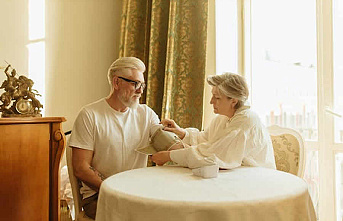more and more young people opt for having a few things in the property and, instead, pay for what is used a time, something that is done with music and movies (who already enjoy streaming and not in physical format) and also with the vehicles (in the big cities there are many brands of rental cars and bikes per minute). Now, this trend also extends to the clothes that you can use on a daily basis: over the past few months, several companies offer to rent clothing for the day-to-day, an initiative that emerged a decade ago in the US which mostly use women and that promotes the circular economy and reducing waste, which leads to the fashion industry. “We are like a Netflix of the closet,” says María José González, of Pislow, one of the companies that offers this service.
The system is simple: you pay a fee per month -that can go from 30 to 150 euros - to change, receive at home a box with three, four, or five items of all kinds. In almost all companies, the first box is a surprise and from there you can choose based on the tastes of the client. Those dresses, blouses and pants can be used for a month and then are returned to the mark, it sends another box with new clothes and is responsible for carrying the clothes to the dry cleaners and leave it ready so that it can be put another person.
“The new consumers, especially from the generation Z, they want to take a look determined, but only once or a few times. This is mainly driven by Instagram, where a lot of people post photos with their style of dress and repeat model is not like the narcissism of this type of consumer,” notes José Luis Nueno, professor of Marketing at IESE Business School and consultant distribution channels. “This all adds up to a serious problem of e-commerce, which is called wardrobing [pun closet and steal]: consumers who buy clothes for get it once and then returned. Brands do not want to end up with a pile of used clothing on your inventory, and therefore are beginning to value the services of chartering,” adds Nueno. The professor points out that this idea started a decade ago in the US with Rent the runway (something like "rent the runway"), a mark that already bill 140 million dollars a year, and now is coming to several European countries, among them Spain.
Pepa Bueno, director of the Association of Fashion Creators of Spain (ACME), which brings together more than 70 designers, believes that this new trend is a return to the fashion always. “With the fast fashion [fast fashion] is starts to wear the clothes of use and throw, but traditionally this has not been so, it is a new phenomenon. The traditional clothing was of good quality, not rushed, was used many times and then gave it to a friend or a family member, even the important parts have always been inherited. Without knowing it, was circular economy,” says Good.
a little over a year, Raul Gonzalez (33 years old) and his wife, the mexican Mercedes Garcia (30 years), they set up one of these new companies, Ecodicta, with headquarters in Madrid, but that works only online. “We were living in Mexico and we had to go to many events and to buy clothes continually. We saw that the closet was growing and it couldn't be bring back. That's why we think this model, which already worked in the U.S.,” Gonzalez says. Send boxes with three, four or five garments for 30, 40 or 50 euros a month. “The clients used quite the clothing, of 5 to 7 times a month. Thus, each garment can get to about 20 users. We compete with the fast fashion saving time and costs”, he adds. What kind of women use it? “A profile of the type of executive or professional that need to be changing clothes constantly. Another profile is the ‘fashionista’ who wants to receive new clothes every month. The third is the millennial that want clothes but you are aware that you have to do something for the environment”.
Elsa Galan, wearing a dress of Slowliove rented through Ecodicta. KIKE TOA client of the first profile is Carolina Sanz, of 40 years and a teacher of social networks in the School of Industrial Organization. “I've noticed that we get very little of the clothing that we have. With this system, instead of buying me the clothes that you wear, I have it for a month, I put it on myself several times and then give it back,” says Sanz. In your case, use the designs to go to work with a point of originality. “Saving a lot of money and I buy a lot less than before. In a year, three friends that I told have signed up to this system,” he adds. Elsa Galan, 33, is closer to the second type of client: works as a consultant of fashion (@waysoflifebyelsa). “I buy a lot of clothes and there are many times that I have enough clothes in the closet that I don't use. This system is very interesting for not having to buy so many dresses and then choose the one with the guilty conscience of not to give me those never. In addition, it is much more sustainable,” says Galán.
Another of these companies is Ouh What Là, with headquarters in Valencia, although it also works only online. “Every year we throw away 800,000 tonnes of textile in Spain and 30% of the clothing that is produced at the global level is not reached or to sell. This model bet for a more responsible consumption and in addition save money and time,” says the founder, Lola Ribas, of 28 years. Your company has some 3,000 women enrolled -“senators, lawyers, housewives...”- that pay between 49 and 89 euros for having garments of mid and high range for a few days. “Are women who love fashion or with a social life very busy,” explains the creator.
María José González, and Sheila Moya, co-founder of Pislow.Sheila Moya (36 years old) and María José González (40 year old) launched in Barcelona Pislow, another platform of rental clothing that works through the Internet. “In our case, the monthly subscription (from 39 to 109 euros) gives the right to two garments and an accessory, like a handbag, a pair of sunglasses or a necklace,” says Gonzalez. Your model includes that, if the client likes the garment, instead of returning it you can choose to purchase it with a discount. All agree that for now only work for women because it is the public that most fashion consumed, although Pislow is already working in take out a subscription for men. In addition, some brands, such as Tous, are beginning to put their own lines of car products in Spain, while H&M has launched a similar service in Switzerland. “In the U.S. this trend is already worth 1,000 million dollars a year, in Spain there will be a large growth in the coming years,” concludes Nueno.
pioneering Experiences that paved the way
Before you put in place these companies across the Internet there have been several attempts building communities for the exchange of clothing. For example, The Closet Club, located in the Rastro of madrid. “We have been running for four years as a club collaborative consumption of clothing, where people pay a monthly fee of 50 euros and could be changed to look for all the times that I would like to”, explains one of its founders Xácome Froufre, of 42 years. “However, at the end of the month we are going to close, because a vulture fund has bought the building and let them chase us out”, he adds. The Closet Club had 60 members from 20 to 45 years and a long waiting list to join. “During this time has been profitable, although in addition to the clothing swap we had the facet of a social club,” says Froufre. In the Raval of Barcelona, worked for a local similar, the Ropateca, which shut down in 2017 after four years of operation.
Date Of Update: 12 January 2020, 01:00









